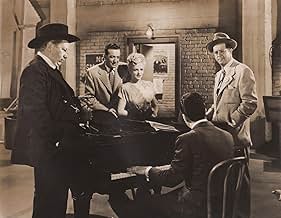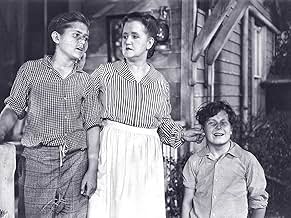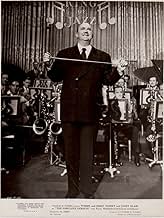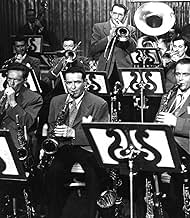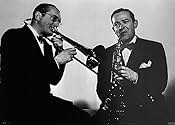IMDb-BEWERTUNG
5,6/10
691
IHRE BEWERTUNG
Füge eine Handlung in deiner Sprache hinzuThe Dorsey Brothers bandleaders' lives traced from childhood music insisting father to fame rise eventual split furthering careers propelling with their music.The Dorsey Brothers bandleaders' lives traced from childhood music insisting father to fame rise eventual split furthering careers propelling with their music.The Dorsey Brothers bandleaders' lives traced from childhood music insisting father to fame rise eventual split furthering careers propelling with their music.
- Regie
- Drehbuch
- Hauptbesetzung
Empfohlene Bewertungen
The miracle in getting this film together was to get the Dorsey Brothers on the same sound-stage for this independent production released by United Artists. The feuding brothers who led two of the best and best known bands of the swing era was a story well known to the American movie going public.
Because of that and because their names and faces were so well known to the American public that certain parameters were put on the producers right from the start. That is the reason the brothers played themselves I'm thinking, despite the fact that as actors they were great musicians. It reminds me of The Jackie Robinson Story which was done a few years later where Robinson played himself and great athlete that he was, he just wasn't an actor.
Carrying the acting part of the film were Janet Blair and William Lundigan playing a singer and piano player whose lives were intertwined with the Dorseys. The only part of the film that was true was the breakup. The two brothers feuded constantly and were most competitive even as kids. As it is shown here, is exactly how the breakup occurred.
Also in the film were Mom and Pop Dorsey played by Sara Allgood and Arthur Shields. It is also true that they did grow up in the Pennsylvania coal mining country and that their father made them take music lessons as a way of escaping that life.
After leaving Paul Whiteman whose orchestra was the nurturing ground for an incredible amount of the musical talent in this country for a couple of generations, the Dorseys did strike out on their own with a joint band. And the split occurred exactly as it is shown on screen, they couldn't do it any other way, the story was part of swing lore. But as individual band leaders Tommy and Jimmy Dorsey scored their greatest success in the swing era. From 1935 when the split occurred until the end of World War II which was the end of the Big Band era, both orchestras were consistently in the top five of bands in any poll that was taken.
Jimmy was the quieter, more restrained and nicer of the brothers. Tommy's temper was legendary, but he had some of the best musicians around in his band and he ran it with an iron fist. One of the big parts of Tommy's story was his singer from 1940 to 1942 who when he went out on his own became probably the most famous graduate of either band. The parting with Tommy Dorsey was not a pleasant one for Frank Sinatra, although later on Sinatra gave Dorsey a lot of credit for the career he had. In fact he said that the way Tommy Dorsey played the trombone was whom he patterned his singing style after.
Jimmy had a couple of pretty good singers with his band as well with Helen O'Connell and Bob Eberly, both who had substantial careers, although not in the Sinatra league. Some five years after this film was made, the brothers did reunite.
Tommy died in 1956, a freak accidental death in his sleep as he regurgitated part of a heavy meal he just had and choked on it because of the pills he had taken. Sadly Jimmy Dorsey at the time of his brother's death knew he had a terminal throat cancer and he died in 1957. Their combined music will live on forever, providing enjoyment to millions.
And the music is the reason to watch The Fabulous Dorseys. This review is dedicated to those battling brothers who made so much good music together and so much better apart.
Because of that and because their names and faces were so well known to the American public that certain parameters were put on the producers right from the start. That is the reason the brothers played themselves I'm thinking, despite the fact that as actors they were great musicians. It reminds me of The Jackie Robinson Story which was done a few years later where Robinson played himself and great athlete that he was, he just wasn't an actor.
Carrying the acting part of the film were Janet Blair and William Lundigan playing a singer and piano player whose lives were intertwined with the Dorseys. The only part of the film that was true was the breakup. The two brothers feuded constantly and were most competitive even as kids. As it is shown here, is exactly how the breakup occurred.
Also in the film were Mom and Pop Dorsey played by Sara Allgood and Arthur Shields. It is also true that they did grow up in the Pennsylvania coal mining country and that their father made them take music lessons as a way of escaping that life.
After leaving Paul Whiteman whose orchestra was the nurturing ground for an incredible amount of the musical talent in this country for a couple of generations, the Dorseys did strike out on their own with a joint band. And the split occurred exactly as it is shown on screen, they couldn't do it any other way, the story was part of swing lore. But as individual band leaders Tommy and Jimmy Dorsey scored their greatest success in the swing era. From 1935 when the split occurred until the end of World War II which was the end of the Big Band era, both orchestras were consistently in the top five of bands in any poll that was taken.
Jimmy was the quieter, more restrained and nicer of the brothers. Tommy's temper was legendary, but he had some of the best musicians around in his band and he ran it with an iron fist. One of the big parts of Tommy's story was his singer from 1940 to 1942 who when he went out on his own became probably the most famous graduate of either band. The parting with Tommy Dorsey was not a pleasant one for Frank Sinatra, although later on Sinatra gave Dorsey a lot of credit for the career he had. In fact he said that the way Tommy Dorsey played the trombone was whom he patterned his singing style after.
Jimmy had a couple of pretty good singers with his band as well with Helen O'Connell and Bob Eberly, both who had substantial careers, although not in the Sinatra league. Some five years after this film was made, the brothers did reunite.
Tommy died in 1956, a freak accidental death in his sleep as he regurgitated part of a heavy meal he just had and choked on it because of the pills he had taken. Sadly Jimmy Dorsey at the time of his brother's death knew he had a terminal throat cancer and he died in 1957. Their combined music will live on forever, providing enjoyment to millions.
And the music is the reason to watch The Fabulous Dorseys. This review is dedicated to those battling brothers who made so much good music together and so much better apart.
Engaging enough fictionalised musical biopic which sees the brothers (who play themselves) playing second fiddle to a lukewarm romance between William Lundigan and the rather lovely Janet Blair for much of the running time.
This black-and-white film seems almost like a documentary, with legendary big band leaders Tommy and Jimmy Dorsey playing fictionalized versions of themselves and delivering many of the hits that made them famous, including "Green Eyes," "I'm Getting Sentimental Over You," and "Marie." Performances by big band musicians and singers from the 1940s, including Art Tatum, Charlie Barnet, Bob Everly, Paul Whiteman, and Helen O'Connell help convey a sense of why this music is such a perfect expression of the American generation that won World War II with its determination and cockeyed optimism. ---from Musicals on the Silver Screen, American Library Association, 2013
I watched this film this afternoon and I am amazed that Janet Blair didn't become one of the great sex symbols of the era. It was only for this beautiful, sexy woman that made me stay with it, (plus the fabulous music). The script was dreadful, the acting (apart from Ms Blair), was embarrasing and the storyline was desperately dull. So in summary if an actress can make me stick like glue to a bomb of a movie like that, she must be something special. Surely we can at least have a headshot!
The condition of the print that was transferred to DVD was just awful. This was no bootleg, either. It's the commercially available disc. That is a pity. Worse is the ham-handed acting and Irish accents think enough to cut with a dull knife. Even Barry Fitzgerald never laid it on that thick.
However... for me, it as all worth it to see Helen O'Connell sing "Green Eyes." Oh yes! So, I hold with many of the others' views: watch this for the music and skip the rest.
It would be a help if the print could be restored to a decent condition and a disc transfer made from that. However, the overall quality of the movie and, sadly, the lack of general interest in good music of the Swing Era, probably doesn't justify the expense.
However... for me, it as all worth it to see Helen O'Connell sing "Green Eyes." Oh yes! So, I hold with many of the others' views: watch this for the music and skip the rest.
It would be a help if the print could be restored to a decent condition and a disc transfer made from that. However, the overall quality of the movie and, sadly, the lack of general interest in good music of the Swing Era, probably doesn't justify the expense.
Wusstest du schon
- WissenswertesBob's concerto in the film is the "Dorsey Concerto", composed by Leo Shuken for the Dorsey brothers.
- PatzerAlthough much of the story takes place in the 1920's and 1930's, Jane's fashions, make-up and hair styles are straight out of the late 1940's when this picture was made.
- Zitate
Mrs. Dorsey: There is only one thing worse than being Irish, and that's not being Irish.
- Crazy CreditsOpening credits appear in the turning pages of a book.
Top-Auswahl
Melde dich zum Bewerten an und greife auf die Watchlist für personalisierte Empfehlungen zu.
Details
- Erscheinungsdatum
- Herkunftsland
- Sprache
- Auch bekannt als
- The Fabulous Dorseys
- Drehorte
- Produktionsfirma
- Weitere beteiligte Unternehmen bei IMDbPro anzeigen
- Laufzeit1 Stunde 28 Minuten
- Farbe
- Seitenverhältnis
- 1.37 : 1
Zu dieser Seite beitragen
Bearbeitung vorschlagen oder fehlenden Inhalt hinzufügen

